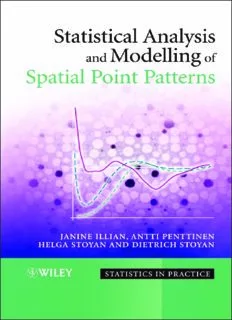Table Of ContentStatistical Analysis and Modelling
of Spatial Point Patterns
Janine Illian
School of Mathematics and Statistics, University of St Andrews,
Scotland, UK
Antti Penttinen
Department of Mathematics and Statistics,
University of Jyväskylä, Finland
Helga Stoyan
Institut für Stochastik, TU Bergakademie Freiberg,
Germany
Dietrich Stoyan
Institut für Stochastik, TU Bergakademie Freiberg,
Germany
This page intentionally left blank
Statistical Analysis and Modelling
of Spatial Point Patterns
STATISTICS IN PRACTICE
Advisory Editors
Stephen Senn
University of Glasgow, UK
Marion Scott
University of Glasgow, UK
Founding Editor
Vic Barnett
Nottingham Trent University, UK
Statistics in Practice is an important international series of texts which provide
detailedcoverageofstatisticalconcepts,methodsandworkedcasestudiesinspecific
fields of investigation and study.
With sound motivation and many worked practical examples, the books show
in down-to-earth terms how to select and use an appropriate range of statistical
techniques in a particular practical field within each title’s special topic area.
The books provide statistical support for professionals and research workers
across a range of employment fields and research environments. Subject areas
covered include medicine and pharmaceutics; industry, finance and commerce;
public services; the earth and environmental sciences, and so on.
Thebooksalsoprovidesupporttostudentsstudyingstatisticalcoursesappliedto
theaboveareas.Thedemandforgraduatestobeequippedfortheworkenvironment
hasledtosuchcoursesbecomingincreasinglyprevalentatuniversitiesandcolleges.
It is our aim to present judiciously chosen and well-written workbooks to meet
everydaypracticalneeds.Feedbackofviewsfromreaderswillbemostvaluableto
monitor the success of this aim.
A complete list of titles in this series appears at the end of the volume.
Statistical Analysis and Modelling
of Spatial Point Patterns
Janine Illian
School of Mathematics and Statistics, University of St Andrews,
Scotland, UK
Antti Penttinen
Department of Mathematics and Statistics,
University of Jyväskylä, Finland
Helga Stoyan
Institut für Stochastik, TU Bergakademie Freiberg,
Germany
Dietrich Stoyan
Institut für Stochastik, TU Bergakademie Freiberg,
Germany
Copyright©2008 JohnWiley&SonsLtd,TheAtrium,SouthernGate,Chichester,
WestSussexPO198SQ,England
Telephone (cid:2)+44(cid:3)1243779777
Email(forordersandcustomerserviceenquiries):cs-books@wiley.co.uk
VisitourHomePageonwww.wiley.com
AllRightsReserved.Nopartofthispublicationmaybereproduced,storedinaretrievalsystemor
transmittedinanyformorbyanymeans,electronic,mechanical,photocopying,recording,scanningor
otherwise,exceptunderthetermsoftheCopyright,DesignsandPatentsAct1988orundertheterms
ofalicenceissuedbytheCopyrightLicensingAgencyLtd,90TottenhamCourtRoad,LondonW1T
4LP,UK,withoutthepermissioninwritingofthePublisher.RequeststothePublishershouldbe
addressedtothePermissionsDepartment,JohnWiley&SonsLtd,TheAtrium,SouthernGate,
Chichester,WestSussexPO198SQ,England,oremailedtopermreq@wiley.co.uk,orfaxedto
(+44)1243770620.
Thispublicationisdesignedtoprovideaccurateandauthoritativeinformationinregardtothesubject
mattercovered.ItissoldontheunderstandingthatthePublisherisnotengagedinrendering
professionalservices.Ifprofessionaladviceorotherexpertassistanceisrequired,theservicesofa
competentprofessionalshouldbesought.
OtherWileyEditorialOffices
JohnWiley&SonsInc.,111RiverStreet,Hoboken,NJ07030,USA
Jossey-Bass,989MarketStreet,SanFrancisco,CA94103-1741,USA
Wiley-VCHVerlagGmbH,Boschstr.12,D-69469Weinheim,Germany
JohnWiley&SonsAustraliaLtd,42McDougallStreet,Milton,Queensland4064,Australia
JohnWiley&Sons(Asia)PteLtd,2ClementiLoop#02-01,JinXingDistripark,Singapore129809
JohnWiley&SonsCanadaLtd,6045FreemontBlvd,Mississauga,ONT,L5R4J3
Wileyalsopublishesitsbooksinavarietyofelectronicformats.Somecontentthatappearsinprint
maynotbeavailableinelectronicbooks.
LibraryofCongressCataloginginPublicationData
Statisticalanalysisandmodellingofspatialpointpatterns/JanineIllian(cid:4)(cid:4)(cid:4)[etal].
p. cm.—(Statisticsinpractice)
Includesbibliographicalreferencesandindex.
ISBN978-0-470-01491-2(cloth:acid-freepaper)
1. Spatialanalysis(Statistics) I.Illian,Janine.
QA278.2.S722008
519.5—dc22
2007045547
BritishLibraryCataloguinginPublicationData
AcataloguerecordforthisbookisavailablefromtheBritishLibrary
ISBN978-0-470-01491-2(HB)
Typesetin10/12ptTimesbyIntegraSoftwareServicesPvt.Ltd,Pondicherry,India
PrintedandboundinGreatBritainbyTJInternational,Padstow,Cornwall
Thisbookisprintedonacid-freepaperresponsiblymanufacturedfromsustainableforestry
inwhichatleasttwotreesareplantedforeachoneusedforpaperproduction.
Contents
Preface xi
List of examples xvii
1 Introduction 1
1.1 Point process statistics 2
1.2 Examples of point process data 5
1.2.1 A pattern of amacrine cells 5
1.2.2 Gold particles 6
1.2.3 A pattern of Western Australian plants 7
1.2.4 Waterstriders 8
1.2.5 A sample of concrete 10
1.3 Historical notes 10
1.3.1 Determination of number of trees in a forest 10
1.3.2 Number of blood particles in a sample 12
1.3.3 Patterns of points in plant communities 13
1.3.4 Formulating the power law for the pair correlation
function for galaxies 15
1.4 Sampling and data collection 17
1.4.1 General remarks 17
1.4.2 Choosing an appropriate study area 19
1.4.3 Data collection 20
1.5 Fundamentals of the theory of point processes 23
1.6 Stationarity and isotropy 35
1.6.1 Model approach and design approach 35
1.6.2 Finite and infinite point processes 36
1.6.3 Stationarity and isotropy 37
1.6.4 Ergodicity 39
1.7 Summary characteristics for point processes 40
1.7.1 Numerical summary characteristics 41
1.7.2 Functional summary characteristics 42
vi Contents
1.8 Secondary structures of point processes 42
1.8.1 Introduction 42
1.8.2 Random sets 43
1.8.3 Random fields 44
1.8.4 Tessellations 46
1.8.5 Neighbour networks or graphs 49
1.9 Simulation of point processes 52
2 The homogeneous Poisson point process 57
2.1 Introduction 58
2.2 The binomial point process 59
2.2.1 Introduction 59
2.2.2 Basic properties 60
2.2.3 The periodic binomial process 62
2.2.4 Simulation of the binomial process 63
2.3 The homogeneous Poisson point process 66
2.3.1 Introduction 66
2.3.2 Basic properties 67
2.3.3 Characterisations of the homogeneous Poisson process 69
2.4 Simulation of a homogeneous Poisson process 70
2.5 Model characteristics 71
2.5.1 Moments and moment measures 71
2.5.2 The Palm distribution of a homogeneous Poisson process 74
2.5.3 Summary characteristics of the homogeneous
Poisson process 78
2.6 Estimating the intensity 79
2.7 Testing complete spatial randomness 83
2.7.1 Introduction 83
2.7.2 Quadrat counts 86
2.7.3 Distance methods 89
2.7.4 The J-test 91
2.7.5 Two index-based tests 92
2.7.6 Discrepancy tests 93
2.7.7 The L-test 95
2.7.8 Other tests and recommendations 97
3 Finite point processes 99
3.1 Introduction 100
3.2 Distributions of numbers of points 104
3.2.1 The binomial distribution 104
3.2.2 The Poisson distribution 106
3.2.3 Compound distributions 107
3.2.4 Generalised distributions 109
Contents vii
3.3 Intensity functions and their estimation 110
3.3.1 Parametric statistics for the intensity function 111
3.3.2 Non-parametric estimation of the intensity function 114
3.3.3 Estimating the point density distribution function 117
3.4 Inhomogeneous Poisson process and finite Cox process 118
3.4.1 The inhomogeneous Poisson process 118
3.4.2 The finite Cox process 123
3.5 Summary characteristics for finite point processes 125
3.5.1 Nearest-neighbour distances 126
3.5.2 Dilation function 127
3.5.3 Graph-theoretic statistics 129
3.5.4 Second-order characteristics 129
3.6 Finite Gibbs processes 137
3.6.1 Introduction 137
3.6.2 Gibbs processes with fixed number of points 139
3.6.3 Gibbs processes with a random number of points 147
3.6.4 Second-order summary characteristics of finite
Gibbs processes 154
3.6.5 Further discussion 156
3.6.6 Statistical inference for finite Gibbs processes 160
4 Stationary point processes 173
4.1 Basic definitions and notation 174
4.2 Summary characteristics for stationary point processes 179
4.2.1 Introduction 179
4.2.2 Edge-correction methods 180
4.2.3 The intensity (cid:2) 189
4.2.4 Indices as summary characteristics 195
4.2.5 Empty-space statistics and other morphological
summaries 199
4.2.6 The nearest-neighbour distance distribution
function 206
4.2.7 The J-function 213
4.3 Second-order characteristics 214
4.3.1 The three functions: K, L and g 214
4.3.2 Theoretical foundations of second-order
characteristics 223
4.3.3 Estimators of the second-order characteristics 228
4.3.4 Interpretation of pair correlation functions 239
4.4 Higher-order and topological characteristics 244
4.4.1 Introduction 244
4.4.2 Third-order characteristics 244
4.4.3 Delaunay tessellation characteristics 247
4.4.4 The connectivity function 248
Description:Spatial point processes are mathematical models used to describe and analyse the geometrical structure of patterns formed by objects that are irregularly or randomly distributed in one-, two- or three-dimensional space. Examples include locations of trees in a forest, blood particles on a glass plat

